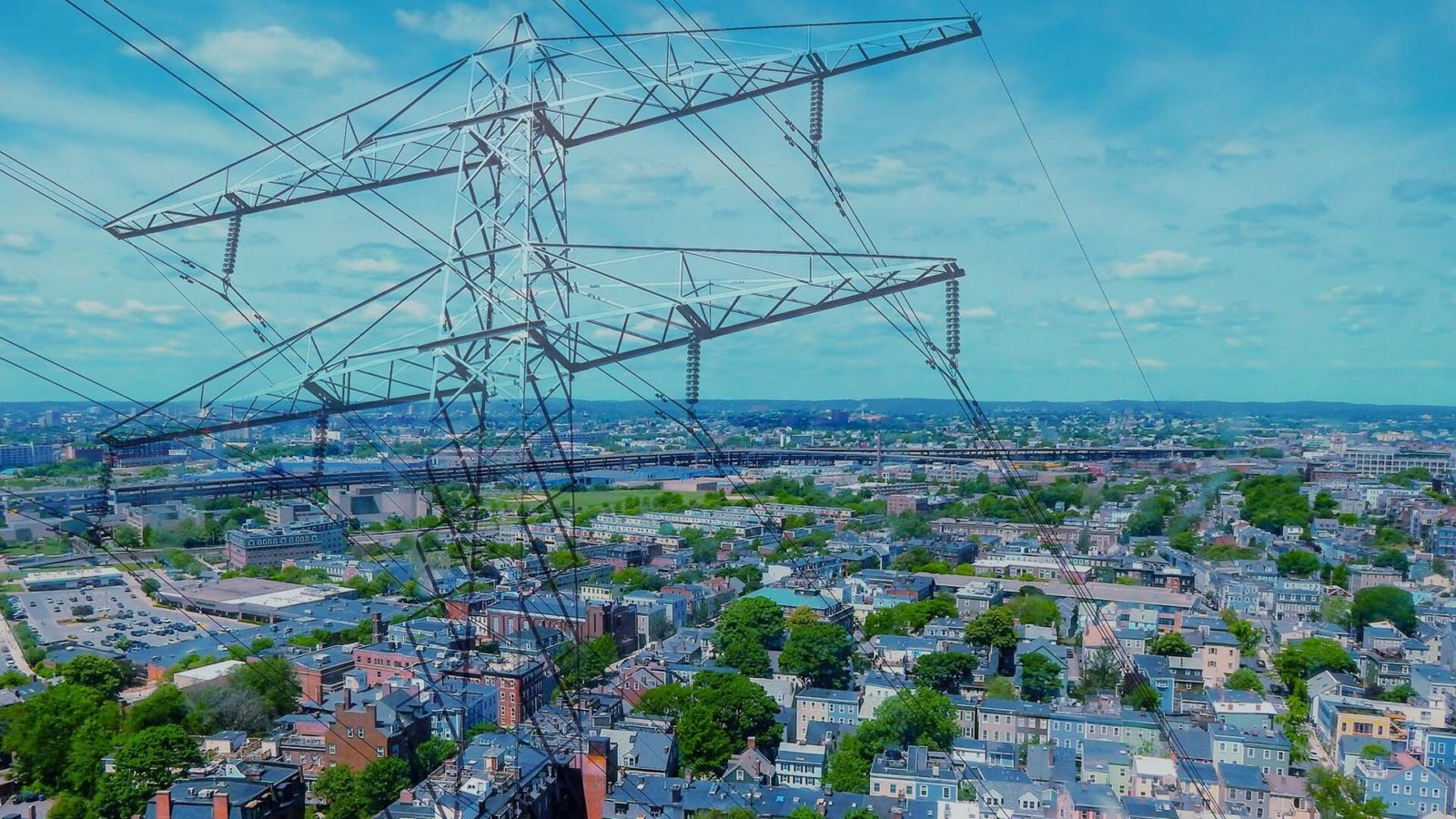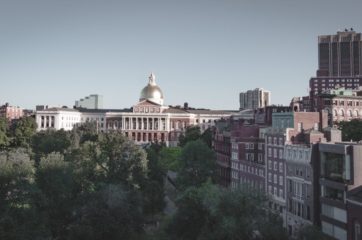As renewable energy continues to grow and influence the energy sector, large scale electricity grids need to adapt, especially in urban and coastal settings that are particularly vulnerable to the threat of climate change. Boston is one of the many cities that is already feeling the impacts of climate change, namely sea-level rise and flooding. The latest projections indicate that sea levels around the city could rise an additional 16 inches by 2050 if climate change continues unabated. Given these changes, it has become increasingly apparent that marginalized communities and communities of color are most at risk for sea-level rise and extreme weather impacts.
Neighborhoods such as Chelsea and Chinatown are two primary examples of communities located in and around Boston that, as of now, are burdened by multiple forms of environmental hazards, weak infrastructure, and stand to be the most impacted by sea-level rise and the severe effects of climate change. In light of these impacts, frontline communities must be equipped with the tools to become more resilient to growing impacts. One solution is microgrids. A small scale electrical circuit/system, microgrids bring benefits such as reliable energy and climate resilience to communities and even cities; however, financial and political obstacles can impede their implementation.
Current Threats
In order to understand how microgrids fit into the climate resilience conversation, we need to have a deep understanding of some of the issues plaguing Boston, issues such as sea level rise, extreme weather, and infrastructure.
Sea-Level Rise in Boston
According to reports from Sealevelrise.org and another from NOAA, sea levels in Boston rise one inch every eight years, increasing a total of eight inches already since 1950. The city’s sea levels may increase ten-fold due to climate change. This means that by 2070, the city would experience 40 inches of sea level rise.
According to the Boston Planning and Development Agency (BPDA), the neighborhoods most at risk of sea level rise consist of Downtown, Seaport, South End, Chinatown, East Boston, Charlestown, and Charles River neighborhoods.
In Chelsea specifically, residents are fighting for their voice to be heard as they request aid from the government to improve community climate resilience as they bear a disproportionate burden of environmental and public health problems. Utilizing the Boston Harbor flood risk model, officials found that 36 percent of Chelsea is within flood risk, with the number jumping to 42 percent in 2030 and 49 percent in 2070. One of the areas of concern stems from Chelsea Creek, which is a largely industrialized area that includes massive salt mounds, petroleum tanks, and is the location of the proposed Eversource substation.
Extreme Weather & Climate
In addition to sea-level rise and flooding, Boston also faces threats of extreme weather. According to the Climate Ready’s Heat Resilience Report, “Boston is experiencing increased temperatures and extreme heat events due to climate change” and, as a result, is having negative effects on “health, infrastructure, economic opportunities, and more.”
Cities experience disproportionately high temperatures relative to suburban or rural communities due to a phenomenon named the urban heat island effect, during which the built city environment absorbs and traps excess heat due to a high concentration of steel and concrete and low concentration of green spaces and trees. In an article from the Boston Globe, journalist David Abel discusses how temperatures in Boston can exceed 90 degrees Fahrenheit for more than 40 days a year and could be as frequent as 90 days by 2070. One study cites that with extreme heat also comes heat-related deaths, which could see a 50 percent increase in the next few decades.
The city of Boston recognizes that underserved communities are often the most impacted. A city report found that low-income communities, such as East Boston and Chinatown, have higher average temperatures than affluent neighborhoods with more trees and green spaces. Many have attributed this issue to Boston’s history of racial inequality. Redlining by banks in certain communities led to residents having difficulty taking out mortgages and less public investment. Areas that banks once deemed “hazardous for loans are now 3.3 degrees warmer than the average, and nearly two degrees cooler at night, with 16 percent less parkland and seven percent fewer trees.” This is a significant difference compared to neighborhoods that banks considered to be “desirable,” where temperatures were “4.2 degrees cooler during the day than the city average and 1.7 degrees less at night, with four percent more parkland and 32 percent more trees.” The city’s Environment Chief, Reverend Mariama White-Hammond, stated, “Historically, we’ve made decisions that have led to these inequities, and now we need to work collaboratively to balance the scales.”
Another issue that many Boston and East Coast residents face is the growing number of nor’easters. Nor’easters are storms along the East Coast that carry strong winds, and are the most frequent and severe from September through April. Due to rising ocean temperatures in the Atlantic, these storm cycles are expected to become a more common occurrence, leaving many coastal cities with billions of dollars in damage to infrastructure, transportation, and human health.
Weak Infrastructure
In addition to facing the impacts of the climate crisis, Boston must also grapple with outdated infrastructure in order to weave deep resilience into the fabric of the city. According to the 2021 Report Card for America’s Infrastructure, Massachusetts received a C- grade, noting rapid deterioration of the state’s infrastructure. The report notes that “Success in a 21st-century economy requires serious, sustained leadership on infrastructure investment at all levels of government.” And, “delaying these investments only escalates the cost and risks of an aging infrastructure system, an option that the country, Massachusetts, and families can no longer afford.”
On top of environmental threats, many residents are also fighting off poverty. Prior to the pandemic, 24 percent were below the poverty level. Since then, the number has risen and collectively families owe an estimated $10 million or more in rent and mortgage payments. An analysis from Climate Central found that coastal flooding will affect affordable housing units, with flooding predicted to triple by 2050. Massachusetts ranks third in having the largest number of affordable housing units that are at risk due to sea-level rise.
The state’s energy infrastructure is another area vulnerable to sea-level rise, extreme weather, and climate change. The Infrastructure Report notes that between 2008 to 2017, there were a total of 823 outages in the state. In March of 2021, the U.S. Department of Energy examined the state’s energy infrastructure and the risks that it routinely encounters. Officials found that between 2009 to 2019 an average of $26 million in property damages due to flooding was lost every year. Flooding, along with winter storms and extreme cold, are estimated to occur 21 times each year with the latter accruing $2 million in property damages. Another area of concern was also thunderstorms and lightning, costing an average of $4 million in damages.
Microgrids
While the impacts of the climate crisis are devastating, there’s room for hope in how we address its effects. Boston-based organizations, such as GreenRoots, Clean Energy Solutions Inc., the Green Justice Coalition, and others have been working to establish microgrids as a method of self-sufficiency and to support the fight for environmental justice. However, it is important to understand what microgrids are and how they differ from a larger electricity grid in addition to the benefits and potential challenges in implementation.
What are Microgrids?
According to the U.S. Department of Energy, microgrids are “a group of interconnected loads and distributed energy resources (DERs) with clearly defined boundaries that acts as a single, controllable entity and can connect and disconnect from the grid to operate in both grid-connected and island mode.” This means that a microgrid, in essence, is an electricity supply in miniature that connects the production and consumption side of the grid at a smaller scale. By today’s definition, most microgrids utilize renewable energy, however, there are some that are powered by generators that run on oil or gas. “Traditionally to generate electricity most efficiently you needed to use large scale facilities, because it was among the cheapest unit costs,” says Carlos Rufín, a Senior Associate for the Institute for International Urban Development and a professor at Suffolk University’s Sawyer Business School who is involved with the project. “The big revolution is that with renewable energy the efficiency scale is much smaller, so you can generate with just a solar panel and that kilowatt per hour cost is cheaper than building a coal power plant,” he says. As a result, microgrids are able to function with or without connection to the larger electricity grid by generating power from local sources such as distributed generators, solar panels, or batteries instead of from a distant source such as a power plant.
It’s important to understand there are a few distinctions between a microgrid and the macrogrid or the national electricity grid. The macrogrid can be a hybrid model of renewable and nonrenewable energies. It’s what some describe as a “highway” of various electrical transmission and distribution lines that connect utilities, facilities, power plants, wind farms, homes, and businesses, providing energy to millions of people in the United States every day.
Microgrids, on the other hand, take the same components of the macrogrid and place it at a small scale, hence the ‘micro.’ Microgrids also provide various benefits, these include improving energy efficiency, decreasing energy costs, and increasing climate resilience, in addition to being able to deploy zero-emission energy sources.

Benefits of Microgrids
One of the current efforts to bring microgrids into Boston is The RUN-GJC Project. This project is a coalition between energy experts, the Resilient Urban Neighborhoods (RUN), and the social and environmental justice organizations, the Green Justice Coalition (GJC). The coalition includes notable organizations such as GreenRoots and other local organizations that are prioritizing the establishment of cloud-based microgrids in Chelsea and Chinatown. In undertaking the RUN-GJC project, it is important to recognize the benefits that microgrids provide.
- Microgrids generate clean and reliable energy to buildings, homes, and communities in an efficient manner. Compared to a macrogrid, which loses an average of five percent of energy during transmission and distribution, microgrids involve short distances from generation to consumption, reducing these energy losses.
- Microgrids can help decrease energy costs. They can also improve local management of electricity and electricity demand to alleviate transmission congestion, which in turn lowers the cost of energy and defers costly investments by utilities towards a new generation. A Climate XChange report found that, in Massachusetts, every $1 million invested in community microgrids saves $440,000 in energy costs for households and businesses. In addition, today’s microgrids rely on non-conventional renewable energy, which has become one of the world’s cheapest energy sources. In the United States, the cost for rooftop solar projects and small scale projects have decreased; however, soft costs such as installations, permitting, and inspection remain high in comparison to other developed markets globally.
- Microgrids play a vital role in increasing climate resilience, especially for frontline communities. Compared to a macrogrid, which is an intricate system of transmission and distribution lines from different energy sources, microgrids can function independently. Even if connected to a central grid, a microgrid is able to disconnect itself and continue providing electricity during a climate-fueled event such as a nor’easter, severe thunderstorms, or extreme heat waves that cause power outages. This concept is known as islanding.
Read the full report from Climate XChange — Investing in a Better Massachusetts: An Analysis of Job Creation and Community Benefits from Green Investments
Local Microgrid Efforts
While the concept and creation of microgrids is not new, it has rapidly gained popularity among low-income and communities of color — who are often on the frontlines of climate change impacts — as a means to support energy democracy. As a result, many have viewed microgrids as a solution towards building climate resilience and encouraging more agency over the energy we use to power our world. In Boston, microgrids are increasingly being considered as a way to prepare high-risk communities for climate impacts like sea-level rise and extreme weather. Two communities working to establish microgrids are Chelsea and Chinatown, both located in the Boston area and burdened by the effects of our warming climate.
Carlos Rufin, who is involved in the projects, says, “The GJC is really present in a lot of these communities. They have the trust of a lot of the people in the community and they are really members of the community, so they have the ability to communicate with the community. By the [Resilient Urban Neighborhoods and Green Justice Coalition] combining, they are able to develop solutions that are truly community based, but also have the technical aspect.”
After experiencing multiple power outages — such as the 2018 power outage that left hundreds without air conditioning during one of the hottest summers, or the October nor’easter that left many throughout the state without power for days — both residents and officials of Chelsea saw the urgency in establishing a microgrid in their community. The city’s design plans are working to ensure that even the most vulnerable have power if the grid fails, and this is where David Dayton comes in. Dayton, CEO of Clean Energies and designer for the cloud-based microgrids, is working with the organizations and the City of Chelsea to establish cloud-based microgrids, which allows for remote management of the electric system. The project, funded by the Massachusetts Clean Energy Center and the Municipal Vulnerability Preparedness Program, enables him to analyze the electrical needs and costs and benefits for installing a microgrid in Chelsea’s city hall.
Dayton highlights that the systems have two main goals — to not only power buildings but to also empower people on the front line of climate change. “Energy is a human right. We want to create what I call fossil-free zones around low-income communities,” he says.
As of now, the plan for Chelsea is to have the system running by 2023 and to include low-income housing and local hospitals later on.
Chinatown also faces various risks of climate impacts, specifically sea-level rise and air pollution due to much of the neighborhood sitting near the Boston Harbor and the Mass Pike. To manage these risks, the director of the Chinatown Community Land Trust wants to establish a cloud-based microgrid for the community. The Chinatown Community Land Trust and the Chinese Progressive Association have developed Chinatown Power, a public benefit company dedicated to establishing a connection between affordable apartments in the area utilizing cloud-based microgrids. Due to the dense population, if multiple buildings were on the microgrid system it would create the possibility to install multiple sources of renewable energy, in addition to providing energy resilience to many residents.
In speaking more in depth about local efforts to implement microgrids, Carlos Rufin discussed the numerous benefits of microgrids:
The most important benefit for these communities is that we can lower the cost for electricity for the people using microgrids. The reason for that is that microgrids not only use solar panels that are competitive in terms of cost with other technologies, but also these projects will involve some investment in energy efficiency, so these units will be improved in terms of insulation and will help the people who live there and will reduce their utility bills.
There is also a resilience benefit, particularly for Chelsea. The area of the Chelsea Creek is flood prone. Chelsea is exposed to the impacts of climate change, and these microgrids, as shown in the case of Puerto Rico seven years ago, can be quite resilient. If the entire grid of New England fails in one of these hurricanes, it is much more likely that the microgrid in Chelsea won’t be affected as severely and will continue to operate or at least restore power back very quickly. This is very important, because hurricanes typically happen in the summer or in the fall, but it could happen at times of high temperatures and we have a lot of older residents in this area. With a microgrid, it can maintain power for at least some air-conditioned areas so that they aren’t affected. Because we have heat waves and those who are most at risk are older people, this would provide that kind of resilience for the community.
Challenges of Microgrids
While the community and environmental benefits of microgrids are clear, there are of course challenges that accompany work to establish these projects. Financing, combating utilities, and simply producing energy itself are obstacles that these systems face. In the United States especially, utility laws are organized as a monopoly and, as a result, make it difficult to establish microgrids in urban areas. Wealth also plays a major role in the establishment of these systems, with wealthier communities having a larger preference.
In conversation with Rufín, he highlights the challenges he and the RUN-GJC project have faced thus far:
The most important challenge, the models for financing microgrids, have favored wealthier communities, large scale businesses, because then the owners are involved and because these places have more money to put upfront and mobilize the investments needed. Whereas disadvantaged communities don’t have a lot of disposable income to pay utility bills, or start off for big investments, they are in rental units. We have that problem, where the intermediary being the owner of the building, the person getting the benefit is the owner and not the tenant, so we have to figure out how to not let that happen.
In a recent report on frontline organizations in Massachusetts from Climate XChange, researchers also note that upfront capital poses a serious barrier for low-income communities and prevents them from benefiting and participating in a green transition. Greener developments and solar array expansions are examples of benefits that are expensive and require substantial upfront funds. When owning a home, energy efficiency developments and other expenses typically pay themselves off over time, the same cannot be said for renters, so there is often a preference towards home equity rather than renting.
Read the full report from Climate XChange — Investing in a Better Massachusetts: Conversations with Frontline Organizations on Connecting Climate and Community Priorities.
Rufin also mentioned that there was a second large obstacle consisting of utility laws. He noted:
The second big obstacle is the utility laws in the U.S. limit the microgrids in urban areas, because the utilities have a concession. They are the monopoly of energy in a given area, they are the owners of the grid in a particular area, they own and operate the electricity grid, and the way this works legally is that no one can place a cable on one side of the street or the other without the permission of the utilities. So, this is a big obstacle, and in fact these two microgrids are going to operate as virtual microgrids. They will operate as a single entity (the production and consumption will be managed centrally), but to send electricity from the production side to the consumption side they will be using the existing electricity network. They have already come to an agreement with the utility companies in Boston, but it’s an obstacle because you will need the utilities to agree, and you will probably have to pay them for the ability to do this. Legally, it is difficult to do this because utilities are protected by a lot of legal precedent, and in reality, they are scared of microgrids, because they will lose a lot of customers and because the customers will become more independent and that they will suffer. I think in reality, many are trying to stop it because they don’t like it.
Looking Ahead
It is imperative to understand that the implementation of the RUN-GJC project is a vital step in the expansion of microgrids and climate resilience throughout the Boston area. After learning about these efforts in Chelsea and Chinatown, cities and neighborhoods such as Cambridge and community groups in Roxbury have expressed their interest in the application of microgrids. The expansion of microgrids constructs the foundation for creating climate-resilient communities and enabling residents to take control of their energy.
As of now, the city of Boston is also taking additional efforts beyond the RUN-GJC project to provide climate resilience. To address the risk of sea level rise, the city developed the Climate Ready Boston Plan in 2016 as a way to prepare high-risk neighborhoods for climate impacts. In order to advance the objectives of climate resilience, the BPDA developed Article 25A – Coastal Flooding Resilience Guidelines & Zoning Overlay District – in 2019. This article “works to protect persons and structures from the adverse effects of sea level rise and storm surge associated with climate change,” which is vital. In a statement, BPDA Director Brian Golden, said: “For Boston to grow and thrive for generations to come, we must ensure that buildings constructed today are resilient and protected from the impacts of climate change, by updating our zoning code to go above and beyond the FEMA flood maps, Boston is leading the way in not only preparing for the storms of today, but the storms of tomorrow.”
As noted by Rufín, the challenges that stand against microgrids are still a prominent obstacle to their development and implementation, but there are a few solutions that can potentially overcome them. For infrastructure, the key to improvement is passing laws that require greater climate risk preparation and management. In addition, having property owners and businesses “improve buildings, create evacuation plans, and mandate insurance” must also be done with the thought that it can improve marginalized communities.
The Green Future Act (H.3292), introduced this session in Massachusetts, stands as a potential solution. Sponsored by Representative Bill Driscoll Jr., the bill works to achieve a green future with infrastructure and workforce investments. As of now, Massachusetts does not have the financial mechanisms it needs to fund its climate goals, meaning the state risks creating a regressive tax model and failing to create local jobs in a sustainable green economy. The bill will also eliminate the pollution fee loophole — as of now, 87 percent carbon pollution is emitted by fossil fuel polluters without paying for the environmental and public health damages it causes. In addition, the bill would establish a state-wide green infrastructure fund that would aid in increasing renewable energy, electrifying transportation, lowering emissions, and preparing residents for climate impacts. The passage of this bill would allow for further progress on microgrids to be established, and strengthen climate resilience in Boston and across Massachusetts.
Learn more about The Green Future Act and the Green Future Now Coalition.
Additionally, the Massachusetts Clean Energy Center has two major programs, the Community Microgrid Program and the Community Clean Energy Initiative. The Community Microgrid Program works to support the development of microgrids throughout communities in Massachusetts in order to lower energy costs, provide energy resilience, and reduce greenhouse emissions. The program announced $1.05 million in funding for community microgrid projects, 14 which are in development across the Commonwealth. The Community Clean Energy Initiative is a $40 million initiative program that works to not only address climate change but to aid cities and towns in utilizing clean energy, including microgrids, and protect communities from service disruptions during extreme weather events.
The mobilization of the people is a final key component in the expansion of climate resilience. Similar to residents in Chelsea and Chinatown, it is important for people to raise their voices in support of the establishment of resilient energy systems and stronger infrastructure. Equally so is the responsibility for those that work within the industry to play a role in taking the steps necessary for this change to occur. Climate mobilization for renewable energy requires rapidly phasing out fossil fuels as a component to the larger issue of the climate crisis. The mobilization towards advancing microgrids can aid in providing climate resilience to frontline communities who are often marginalized communities, in addition to playing a valuable role in removing planet-warming emissions from utilities.










